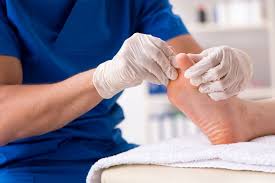A foot doctor is a general term for a doctor of podiatric medicine (DPM). A DPM can be either a chiropodist or a podiatrist. Both are trained to diagnose and treat medical conditions affecting the feet, ankles and lower legs.
A chiropodist is a doctor who specializes in the treatment of the feet, ankles and lower legs. The term “chiropodist” is used in Europe to refer to someone who treats feet, while “podiatrist” or “foot doctor” are used in North America. Chiropodists have at least five years of post-secondary education, which includes an undergraduate degree followed by four years of professional training at an accredited chiropody program recognized by the National Accreditation Council for Podiatric Medical Education (NACPME).
A chiropodist can perform some of the same procedures as a podiatrist — such as surgery — but they are not authorized to prescribe drugs or perform surgical procedures involving internal organs.
Podiatrists complete an additional two years of post-graduate residency training in order to obtain their license from the provincial college responsible for their jurisdiction. This training requires that they complete more than 500 hours of clinical experience before qualifying for their license and practice independently
What is difference between podiatrist and chiropodist?
Podiatrists are doctors who specialize in treating the foot and ankle. They can perform surgery, treat injuries and deformities, and provide medical care for other problems.
Chiropodists are healthcare professionals who specialize in diagnosing and treating disorders of the feet and lower limbs. Chiropodists provide medical care for people with diabetes, vascular diseases (like high blood pressure), infections (like athlete’s foot), and skin diseases (like eczema). Chiropodists also fit special shoes or inserts to help people with foot problems walk better.
Podiatrists usually have a Doctor of Podiatric Medicine (DPM) degree, while chiropodists usually have an Associate Degree in Allied Health Sciences or Certificate of Competency in Foot Health Care. Both types of health care professionals may take continuing education courses to keep their skills up-to-date.
What is the most common problem treated by podiatrist?
Podiatry is the medical and surgical treatment of conditions of the foot, ankle and lower extremities. Podiatrists are trained in the diagnosis and treatment of all problems relating to the foot, ankle and leg. Podiatrists diagnose conditions such as heel pain, diabetic foot care, bunions, ingrown nails and other foot problems. They also perform surgery on the ankle and foot such as hammertoe surgery, bunion surgery and more.
The most common problem treated by podiatrists is ingrown toenails or nail fungus.
Do podiatrists cut toenails?

Podiatrists are trained to trim the nails of the feet and hands. This is a skill that they must learn and perfect in order to be able to provide their patients with the best possible care.
When you visit your podiatrist, you may notice that he or she uses a variety of tools and instruments when trimming your nails. These include:
Nail clippers: These are small scissors that can be used for small areas of the nail bed. They are typically used for filing down hard skin on the feet or for removing hangnails from around the edges of your nails.
Callus shavers: A callus shaver is a medical tool that looks like an electric razor blade, but it does not cut as deeply into the skin like a regular razor blade would. Instead, it gently scrapes away layers of dead skin and calluses on your fingers and toes to reveal healthier layers underneath them.
Guillotine trimmers: A guillotine trimmer is a medical instrument that resembles a pair of scissors, but it lacks thumb holes so that users can apply more pressure when cutting tissue with it. Podiatrists use this type of instrument when trimming corns or calluses off their patients’ feet because it allows them to apply
Why do elderly get thick toenails?
While it’s normal for toenails to thicken as you grow older, it can be a sign of an underlying medical condition if your nails become very thick and discolored.
Thickened toenails are usually caused by trauma or injury to the nail bed. If you’ve injured yourself and had toenail surgery, it’s likely that you will notice a thicker nail growing in its place.
In addition, people with diabetes often have thickened nails due to poor circulation, which reduces oxygen and nutrients that your body needs to maintain healthy skin and nails.
If your nail is thickened but not colored or pitted, it’s probably just caused by aging or a lack of proper care. These changes may be temporary but can also be permanent if they aren’t treated properly.
Should I cut my toenail fungus?
If you have toenail fungus, you may be tempted to try a home remedy or two. But it’s best to leave the problem to your doctor.
“If it’s a small area of mild infection, a topical medication may be used,” says Dr. Charles Crutchfield, an assistant professor of dermatology at Wake Forest Baptist Medical Center in Winston-Salem, North Carolina. “But if there’s a large area of infection or one that hasn’t responded to other treatments, it should be treated by a dermatologist.”
Toenail fungus is caused by an overgrowth of a fungus called dermatophyte (pronounced der-mah-toh-FITE). This fungus can live on dead skin and hair follicles and thrives in warm, moist environments like shoes and socks. The organism invades healthy tissue under the nail bed and begins to grow into the nail itself.
If left untreated, the nail will become thickened and discolored as new layers of cells are added on top of each other over time.
What kills toenail fungus?
What kills toenail fungus? Toenail fungus is caused by a type of fungus called dermatophytes. These are the same kinds of fungi that cause jock itch, athlete’s foot and ringworm. The most common treatment is an anti-fungal cream or ointment that you apply to your affected nails daily for several weeks.
You can also use over-the-counter or prescription antifungal pills to treat toenail fungus. Some people find that combining oral medications with topical treatments works best for them. Others prefer one method over another, and still others have no success with either treatment alone.
What kills toenail fungus? The good news is that many types of topical antifungal creams and lotions work well at clearing up toenail fungus in most people who use them for several months or more. In fact, some brands have been shown effective in as few as 12 weeks when used properly.
One drawback is that it’s important not just to use the appropriate medication but also to apply it every day as prescribed by your doctor or pharmacist — otherwise, the infection may return or worsen again later on down the road
How do I get rid of toenail fungus permanently?

Toenail fungus is a condition that affects the toenails. It is characterized by ugly yellow and brown spots on the nail and can be painful. Toenail fungus can be caused by wearing shoes that are too tight, excessive moisture, going barefoot in public places, trauma to the toes and other factors.
Toenail fungus may occur when a fungus called dermatophyte invades the skin of your toes and nails. The symptoms of this infection include thickening of your nails, discoloration of your nails, inflammation around the nail and pain in the affected area. Toenails that have been infected with this condition may also become brittle and crumbly as they grow outwards from your toe.
In some cases, you may choose to treat this condition on your own using over-the-counter medications or home remedies such as vinegar and tea tree oil soaks or warm water baths. However, if you are unable to get rid of your infection using these methods then you should visit a doctor who will prescribe an oral or topical antifungal medication that is effective at killing off existing fungal infections while preventing new ones from forming in future.
If you wish to try treating your condition at home then here are some home remedies
Is it OK to wear nail polish with toenail fungus?
Nail polish is not only a great way to make your fingernails look fabulous, but it can also protect your nails from damage. Your fingernails are exposed to many different chemicals and harsh conditions, so it’s important to protect them. Nail polish can help protect your nails from water, detergents and other chemicals. However, there are some things you should know about wearing nail polish if you have toenail fungus.
Is it OK to wear nail polish with toe fungus? You may be able to wear nail polish on your toes if you have toe fungus (onychomycosis). However, you’ll need to be careful about what type of nail polish you use and how long you keep it on your toes.
Can I wear nail polish with toenail fungus?
You may be able to wear nail polish on your fingernails if you have toenail fungus. However, you’ll need to be careful about what type of nail polish you use and how long you keep it on your nails.
Does VapoRub work for toenail fungus?
Vicks VapoRub is a medicated ointment that contains camphor and menthol. The main use of this ointment is to treat coughs and colds, but it can also be used to treat your toenail fungus.
The active ingredients in Vicks VapoRub are camphor and menthol. Camphor is a cooling agent that helps relieve pain and itching, while menthol has a numbing effect on the skin. Both of these ingredients can help relieve the symptoms of toenail fungus by killing off the fungus and reducing inflammation.
Using Vicks VapoRub to Treat Toenail Fungus

In order to successfully treat your toenail fungus with Vicks VapoRub, you will need to apply the medication directly onto your infected nails twice daily for at least 2 weeks. Start by washing your feet with warm water and soap before applying the ointment. Then, rub some of the ointment onto each infected nail using your finger or a cotton swab (you may have to cut each nail shorter first). Avoid getting any of the medication into healthy areas surrounding your nails since this could cause irritation or burning sensations in these areas. You should also avoid getting
What is the difference between a foot and ankle doctor and a podiatrist?
The short answer to this question is that there are no differences between foot and ankle doctors and podiatrists.
Both types of healthcare professionals are trained to diagnose and treat conditions affecting the feet, ankles, and lower leg. Both types of doctors use terms like “foot doctor” and “podiatrist.” But some people use these terms interchangeably.
What do they do?
Foot doctors (also called podiatrists) focus on medical issues related to the foot, ankle, and heel. They diagnose conditions such as bunions, hammertoes, ingrown toenails or calluses, and heel pain caused by plantar fasciitis. They also provide treatment for these conditions using techniques such as surgery or injections of drugs or steroids.
Podiatrists may perform surgery on the ankle joint (tarsal tunnel release) to treat nerve compression in the lower leg caused by wearing high heels or other tight-fitting shoes that press against nerves in the lower leg. They may also perform surgery on tendons around the heel bone (calcaneus) to relieve pressure on nerves in this area caused by plantar fasciitis or heel spurs. Podiatrists may perform surgery on your big toe joint (metatarsophalange
What’s the difference between a podiatrist and an orthopedic foot doctor?
A podiatrist is a doctor of podiatric medicine who diagnoses and treats disorders of the foot, ankle and lower leg. The word podiatry comes from Greek words meaning “to care for the foot.”
An orthopedic foot surgeon is a specialist in surgery on bones and joints of the lower extremity (i.e., hip, knee and foot). An orthopedic surgeon has completed 4 years of medical school followed by 3 years of residency training in orthopedics.
The differences between these two types of doctors are:
- Training – A podiatrist has completed 4 years of specialized training to diagnose and treat disorders of the foot, ankle, and lower leg. An orthopedic foot surgeon has completed 4 years of medical school followed by 3 years of residency training in orthopedics.
- Scope Of Practice – Podiatrists treat everything from ingrown toenails to bunions; they also perform surgery on bunions and other conditions affecting the feet. Orthopedic surgeons focus mainly on surgery on bones and joints in the lower extremity (hip, knee or foot). However both do see patients with injuries to their feet or ankles such as sprains or strains that may require casting or bracing.
Podiatrists and orthopedic foot doctors are both healthcare professionals who treat conditions of the foot, ankle, and lower leg. However, there are some distinct differences between the two professions. In this article, we’ll explore the similarities and differences between podiatrists and orthopedic foot doctors so you can determine which one is best for your needs.
What Is a Podiatrist?
Podiatrists (also known as “foot doctors”) have completed a four-year doctorate degree. They may choose to specialize in one area of foot care or practice general podiatry. Specialized podiatrists include pedorthists (who fit custom-made shoes), clinical biomechanics (who study human movement), and sports medicine specialists (who focus on athletic injuries).
Podiatrists perform many of the same procedures as an orthopedic foot doctor (such as removing ingrown toenails) but they also provide other important services such as diabetic wound care and bone surgery if necessary. A podiatrist may also assist in fitting custom-made shoes if needed by their patients.
What Is an Orthopedic Foot Doctor?
Orthopedic foot doctors are medical doctors who specialize in treating conditions affecting the feet, ankles

